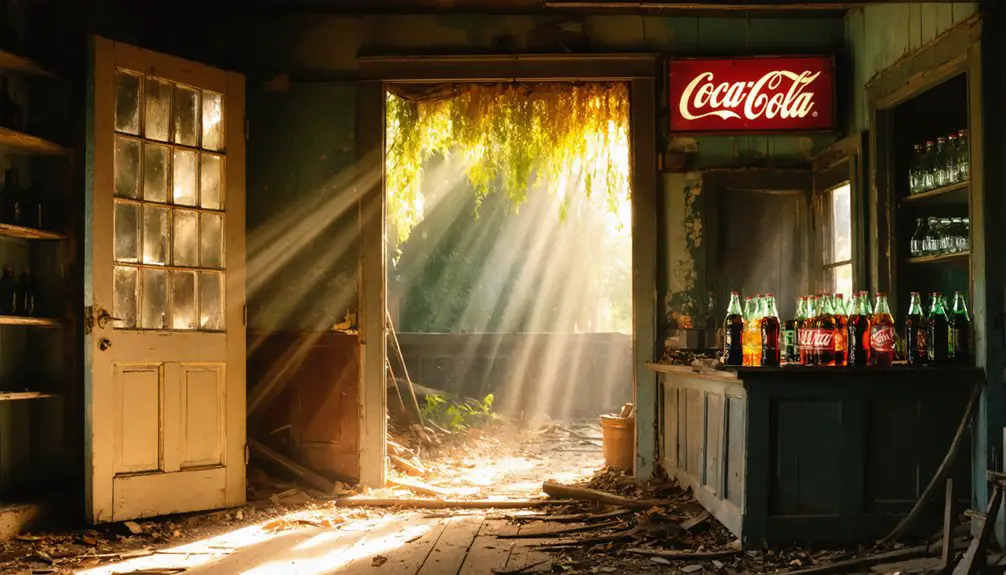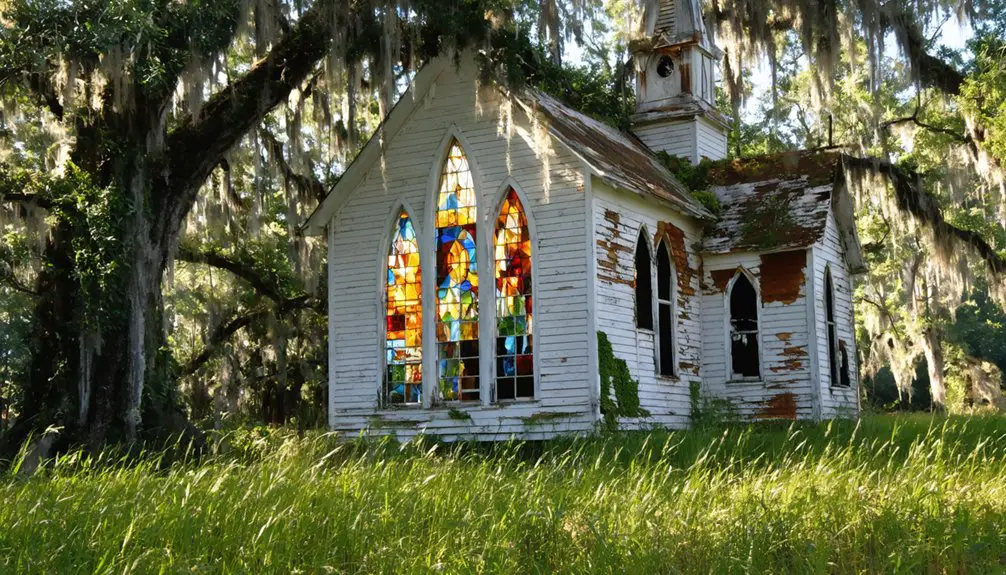You’ll discover Mabel’s fascinating story as a Florida ghost town that emerged during the late 1800s railroad boom. This working-class community, peaking at 1,500 residents, thrived through sawmills, citrus groves, and agriculture near the Florida Central and Peninsular Railroad. Natural disasters, including devastating floods and fires, ultimately led to Mabel’s decline in the early 20th century. Local historical societies now work to preserve the rich heritage of this once-bustling railroad stop.
Key Takeaways
- Mabel was a thriving Florida railroad town that peaked at 1,500 residents before becoming abandoned due to natural disasters.
- The town’s economy centered on timber, sawmills, and agriculture until repeated flooding and fires led to its decline.
- Multiple natural disasters, including the Big Freeze of 1894-95 and Suwanee River floods, devastated the town’s infrastructure.
- The town featured a bakery, hotel, boat works, cement plant, and railroad connections before mass outmigration occurred.
- Archaeological surveys and historical preservation efforts document Mabel’s remaining foundations and protect its legacy as a ghost town.
The Birth of a Railroad Community
As Florida’s railroad expansion gained momentum in the late 19th century, Mabel emerged as one of many small communities that sprouted along the Florida Central and Peninsular Railroad‘s growing network.
You’ll find Mabel’s railroad history deeply intertwined with the FC&P’s strategic development, which connected Jacksonville to Tampa while establishing essential links between rural areas and major ports.
The town’s community growth reflected a common pattern of the era, as settlers and workers were drawn to these railway stops. Lake Mabel was one of several historic stops along the Orlando & Winter Park Railroad.
When the FC&P merged into the Seaboard Air Line Railway in 1900, Mabel continued to benefit from its position along this significant transportation route. The Western Division route from Jacksonville to Tallahassee provided crucial transportation infrastructure for the region’s development.
Like many railroad towns of its time, Mabel served as a hub for supplies, services, and residential life for railway workers and travelers.
Daily Life in Early Mabel
While records paint an incomplete picture of early Mabel, the town’s daily rhythms centered around its working-class families who settled there in the late 1800s.
You’d have found residents spending their days laboring in nearby sawmills, citrus groves, and farms, with work schedules following the natural seasons and daylight hours.
Community activities revolved around the town’s churches and one-room schoolhouse, where family gatherings brought residents together beyond Sunday services.
Beyond Sunday worship, Mabel’s churches and schoolhouse acted as social anchors, fostering community bonds through regular family gatherings.
You’d likely have attended social events at the local boarding houses or post office, which served as key meeting spots.
The simple wood-frame homes clustered near transport routes, and daily life meant collecting mail and supplies from Postmaster Phelps’ office.
Whether Methodist or Baptist, you’d have found strong religious ties binding the community together.
Like many Florida timber settlements of the era, the town’s prosperity depended heavily on the Southern States Lumber operations.
Like other towns in the region during 1894-1895, Mabel faced devastating winter freezes that threatened local agriculture.
Economic Rise and Agricultural Heritage
Once a thriving sawmill community, Mabel’s economic prosperity peaked with a population of 1,500 residents supported by diverse local businesses.
You’d find a bustling town center with a bakery, hotel, boat works, and cement plant, all driven by the booming timber extraction industry that attracted workers and their families.
When timber resources eventually ran low, the region’s economy shifted toward agriculture.
The local wooden fruit baskets production at the sawmill supported the area’s agricultural endeavors before its eventual decline.
You can trace this transformation through innovative water management systems, including the development of essential canal networks.
These agricultural innovations turned previously swampy terrain into productive farmland.
Hamilton Distin’s dredging projects in 1882 were crucial for opening waterways and enabling agricultural development.
Companies like Alico led the charge, converting 70,000 acres into thriving tree farms and cropland.
The area’s citrus industry particularly flourished as northern freezes pushed growers south, establishing a new agricultural legacy in Hendry County.
Natural Disasters and Town Decline
Natural disasters played a devastating role in Mabel’s downfall, striking repeated blows to the community’s infrastructure and economic foundation. Despite attempts at disaster recovery, the town couldn’t overcome the combined impact of floods, fires, and severe weather events. The general store fire in 1921 further diminished the town’s commercial vitality. Like today’s unavailable content, many of the town’s historical records were lost to these disasters.
You’ll find that flooding from the nearby Suwanee River repeatedly damaged essential structures, while devastating fires, including the 1898 sawmill blaze, crippled the town’s economic engine.
- The Drew Mansion’s destruction, first by flood damage and later by fire in the 1970s, symbolized the town’s declining fortunes.
- The Big Freeze of 1894-95 devastated regional industries.
- Repeated floods weakened bridges, stores, and fueling stations.
- Community resilience faltered as natural disasters triggered mass outmigration, leading to abandoned businesses and civic institutions.
Preserving Mabel’s Lost Legacy

Despite the physical deterioration of Mabel’s remains, dedicated preservation efforts have emerged to protect and document this vanished community’s heritage.
Local historical societies actively gather photographs, maps, and written accounts to safeguard Mabel’s story from being lost to time. Through community engagement, you’ll find small museums in nearby areas working to preserve artifacts and records that tell of Mabel’s past.
Archaeological surveys have documented the remaining foundations and structures, while historical documentation efforts continue through partnerships with regional organizations. Similar to Doors Open California, these initiatives make heritage sites accessible to interested visitors. The struggle against encroaching jungle vegetation threatens to further obscure the archaeological evidence.
You can explore this heritage through educational programs and guided tours when available, though Florida’s challenging climate and rapid development threaten what’s left.
The preservation of Mabel’s legacy relies heavily on ongoing community support and awareness campaigns to guarantee its place in Florida’s history.
Frequently Asked Questions
Are There Any Remaining Buildings or Structures From Mabel’s Past?
You’ll find old barns and deteriorating sheds along the Van Fleet Trail, plus abandoned trailers and structures scattered in the woods – all remaining structures with historical significance to Mabel’s railroad-linked past.
What Was the Peak Population of Mabel During Its Heyday?
Like a bustling beehive around its sawmill heart, population dynamics show Mabel’s historical significance peaked at approximately 1,500 residents during its industrial prime, when you’d have found thriving community life.
Did Any Famous People or Events Originate From Mabel?
You won’t find any famous residents or events originating from this locale, except for its connection to Postmaster J.P. Phelps’s daughter Mabel, who gave the town its historical significance.
What Happened to the Original Families Who Settled in Mabel?
By 1930, nearly 90% of the original settlers had moved away. You’ll find their family legacy scattered across Florida as settlement challenges and economic hardships forced them toward more prosperous developing towns.
Were There Any Schools or Churches Established in Mabel?
While you’d expect to find Mabel schools and churches in a settled community, there’s no concrete evidence they existed. Records don’t confirm any formal educational or religious institutions in the town.
References
- https://www.palatkadailynews.com/local-around-putnam/exploring-putnam-countys-past-look-local-ghost-towns
- https://www.ghosttowns.com/states/fl/mabel.html
- https://www.youtube.com/watch?v=Lv9sIPn3NgU
- https://www.youtube.com/watch?v=kXGAKmjGMXg
- https://www.tiktok.com/@socialshepherdadventures/video/7342301852702100778
- https://en.wikipedia.org/wiki/Florida_Central_and_Peninsular_Railroad
- https://citruslandfl.blogspot.com/2016/08/
- https://citruslandfl.blogspot.com/2016/08/the-orlando-winter-park-no-dinky-line.html
- https://www.pioneerfloridamuseum.org/index.php?option=com_content&view=category&layout=blog&id=15&Itemid=39
- https://www.floridastateparks.org/learn/history-railroad-and-war-hero



